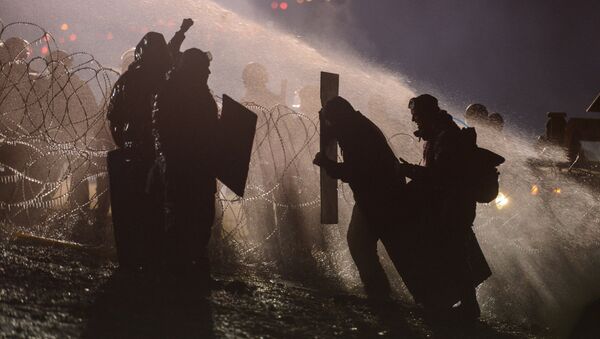Though many activists faced brutal force during the 2016 to 2017 protests, from being doused with water in freezing temperatures to being hit with rubber bullets by law enforcement officials, the violence that was committed against one individual in particular raised the alarm regarding what was happening to the water protectors.
In November 2016, Marcus Mitchell was studying mechanical engineering at Northern Arizona University when he saw footage of police spraying activists opposing the Dakota Access Pipeline (DAPL) with water and targeting them with concussion grenades. He then dropped out of school to join the fight to protect the sacred lands of the Standing Rock Sioux from being destroyed by DAPL.
Two months after hopping onboard, however, Mitchell was shot with a bean bag pellet by a Morton County sheriff's deputy during a standoff against officials. The pellet, which entered Mitchell's left eye, took away his sight in that eye and his ability to taste and to feel parts of his face. It also left him partially deaf in his left ear and damaged his cervical spine.
Now, more than a year after the violent incident, Mitchell is being charged with criminal trespass and obstruction of government function, according to The Guardian, which reported that he could face the maximum sentence of two years in prison and be forced to pay a $6,000 fine.
Mossett told Radio Sputnik's Loud & Clear on Thursday that on January 19, 2017, the day Mitchell was shot, officials were using demonstrators for "target practice."
"It's one of those things where there were so much mass chaos and confusion going on," she told host Brian Becker. "So many people getting hurt… of those several hurt, they were getting shot either in the face or the groin."
"[When] Marcus got hit with the bean bag… people didn't even know where he was… it was really sick the way he was treated after having been shot," she added.
After Mitchell was taken away by paramedics to the Stanford Medical Center in Bismarck, North Dakota, his whereabouts weren't disclosed to worried family members. Instead, Mitchell was kept shackled to his hospital bed as officers questioned him about weapons they said were stashed at the Standing Rock camps and about other plans the water protectors had in store. The phone inside Mitchell's hospital room was also taken away, and a security guard was stationed outside his door.
"For them to be treating him like a common criminal in that state is pretty sickening, and to have a person outside of his door — like a private security person — as if he was going to go anywhere is really sickening," Mossett said.
"It's been 500 years; colonization has come, and native people have survived through an era of termination when there was an ‘Indian problem' in this country. They're trying to still get rid of us; it's just in a different context," she stressed.
The violence at Standing Rock is "a prime example of what the foundation of this country was built upon, which is the taking and raping of the Earth and pillaging of other peoples' lands," according to Mossett.
Prior to the Standing Rock movement, there was the Wounded Knee occupation in 1973 in South Dakota by some 200 Oglala Lakota and supporters, who criticized the US government for failing to fulfil treaties with Native Americans.
Throughout that 71-day siege, shots were exchanged between the members of the American Indian Movement (AIM) and law enforcement. Deaths were reported on both sides. Leonard Peltier, a member of AIM, was later convicted of first-degree murder and sentenced in 1977 to two consecutive life sentences for the deaths of two FBI agents.
"We never went away. Standing Rock was just another uprising," Mossett told Becker.
According to The Guardian, Mitchell's trial is scheduled to begin on November 8 in Mandan, North Dakota.



